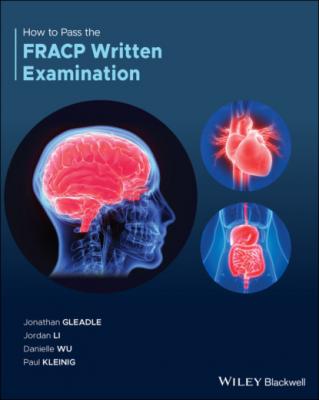How to Pass the FRACP Written Examination. Jonathan Gleadle
Читать онлайн.| Название | How to Pass the FRACP Written Examination |
|---|---|
| Автор произведения | Jonathan Gleadle |
| Жанр | Медицина |
| Серия | |
| Издательство | Медицина |
| Год выпуска | 0 |
| isbn | 9781119599548 |
Rose J, Wang L, Xu Q, McTiernan C, Shiva S, Tejero J et al. Carbon Monoxide Poisoning: Pathogenesis, Management, and Future Directions of Therapy. American Journal of Respiratory and Critical Care Medicine. 2017;195(5):596–606.https://www.atsjournals.org/doi/full/10.1164/rccm.201606‐1275CI
4. Answer: B
Disseminated intravascular coagulation (DIC) is an overactivation of the coagulation cascade resulting in consumption of coagulation factors, and disordered haemostasis, manifesting as either coagulation or bleeding. DIC affects about 35% of patients who have sepsis. Depending on the cause, DIC manifests in different ways. This is thought to be due to differential effects of the causative pathology on fibrinolysis and procoagulant factors. For example, DIC caused by trauma or acute promyelocytic leukaemia tends to result in bleeding, whereas sepsis most frequently causes multi‐organ dysfunction through microembolic damage. Obviously, the treatment of these differentially manifesting pathologies will differ. The typical laboratory parameters in DIC are decreased platelet count, increased prothrombin time, increased (often dramatically) D‐dimer, and decreased fibrinogen. However, the individual components of laboratory diagnosis are not all required and DIC can go undiagnosed if this possibility is not recognised. For example, low fibrinogen is only present in around 30% of DIC associated with sepsis. One of the most thoroughly validated scoring systems for the diagnosis of DIC is that of the International Society of Thrombosis and Haemostasis (ISTH), which gives weight to the above‐mentioned laboratory parameters and a score of 5 or more denotes DIC. There is still some controversy surrounding the supportive management of DIC (other than addressing the underlying cause), but treatment strategies in sepsis induced DIC include replacing factors, activated protein‐C and systemic anticoagulation.
Iba T, Levy JH, Warkentin TE et.al. Diagnosis and management of sepsis‐induced coagulopathy and disseminated intravascular coagulation. J Thromb Haemost. 2019; 17(11): 1989–1994.
https://onlinelibrary.wiley.com/doi/10.1111/jth.14578
5. Answer: B
Septic shock is a type of distributive shock and is the most common cause of circulatory shock among patients in the ICU (62% of the patients). It is followed by cardiogenic (16%), hypovolemic (16%), and obstructive shock (2%). Causes of shock may be obvious from history, clinical examination, and/or investigations. Patients who present with a history of trauma/gastrointestinal bleeding may have hypovolaemic shock; patients with massive pneumothorax/pulmonary emboli/cardiac tamponade are likely to have obstructive shock; patients with fever, symptoms/signs of infection, an elevated WBC count, a high CRP, and an elevated procalcitonin level may have septic shock; patients present after a recent acute coronary syndrome are likely to have cardiogenic shock, etc. Some patients may have mixed types of circulatory shock.
Initial presentations may be similar in patients with different types of shock. Depending on the organ involvement after circulatory shock, the patient may have mental status changes, hypotension, tachycardia, tachypnoea, reduced urine output, coagulation abnormalities, etc. Blood lactate levels are elevated in patients with impaired tissue perfusion.
Further investigations by performing a septic screen, assessing cardiac output by echocardiogram, monitoring mixed venous oxygen saturation (SvO2), monitoring of central venous pressure, or performing a CTPA can help to differentiate the underlying cause(s) of circulatory shocks. If an echocardiogram shows large ventricles and poor contractility, cardiogenic shock is likely. An echocardiogram may help to rule out pericardial effusion, cardiac tamponade, etc. some of the common causes of obstructive shock.
After failing initial intravenous fluid resuscitation, it may be appropriate to provide vasopressor support, intensive blood pressure monitoring via an arterial line, and central venous catheters in the ICU if patients wish to have more intensive monitoring and treatment. Broad spectrum antibiotics administration according to the possible sites of infections should be considered as soon as possible without delay after a septic screen is performed if there is suspicion of septic shock, to minimise morbidity and mortality associated with sepsis.
Vincent J, De Backer D. Circulatory Shock. New England Journal of Medicine. 2013;369(18):1726–1734.https://www.nejm.org/doi/10.1056/NEJMra1208943
6. Answer: A
The ECGs show
1 Left bundle branch block (LBBB)
2 ST change associated with severe left ventricular hypertrophy (LVH)
3 ST changes associated ‘Tented’ T wave in patient with hyperkalaemia
4 Widespread concave (‘saddleback’) ST segment elevation in a patient with pericarditis
The key point is that not all ST elevation is due to ST elevation acute myocardial infarction (STEMI). ECG A is typical for LBBB which is new. New LBBB alone is not necessarily an indication for immediate cardiac catheterisation. However, the following criteria are the indications for immediate cardiac catheterisation:
Unstable patient with hypotension, acute pulmonary oedema or electrical instability
Sgarbossa Criteria (electrocardiographic findings used to identify myocardial infarction (MI) in the presence of a LBBB)Concordant ST‐segment elevation of 1 mm in at least 1 leadConcordant ST‐segment depression of at least 1 mm in leads V1 to V3
Smith‐Modified Sgarbossa criteria – any single lead with at least 1 mm of discordant ST elevation that is ≥25% of the preceding S‐wave.
In patients with old LBBB, ST–T abnormalities are common, making it difficult to assess the presence of AMI. ST segment and T–waves are usually discordant with the QRS in LBBB, since they are directed in opposite directions. A concordant ST segment shift should always be presumed to be a myocardial lesion and considered as strongly indicative of AMI. On the other hand, a discordant ST segment displacement may be indicative of a myocardial lesion when specific standard criteria are exceeded. For example, discordant elevation of the J point ≥0.5 mV in V1–V2 is strongly suggestive of AMI in the presence of LBBB. Moreover, in LBBB, the QRS/T ratio appears to be more predictive than the amplitude of ST elevation. When this ratio is near to or less than 1, the probability that the repolarisation abnormality is related to an MI is high.
ECG
